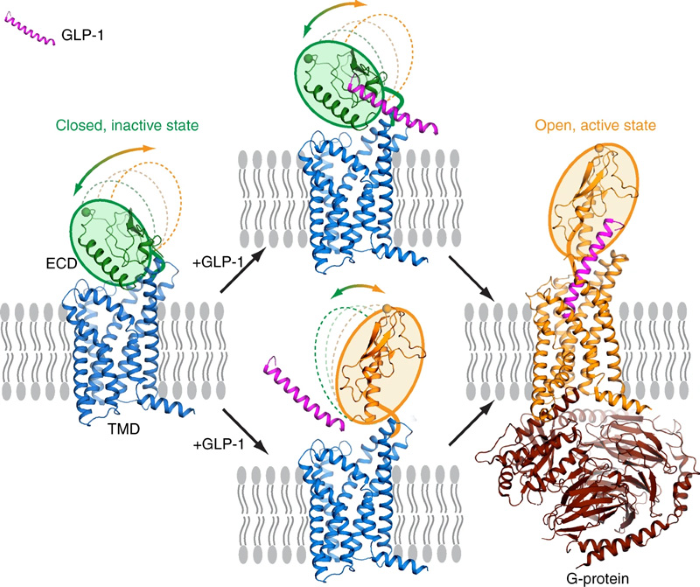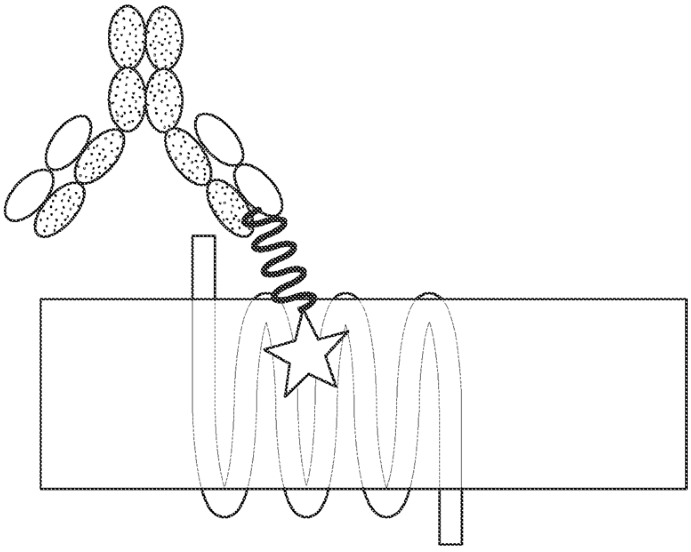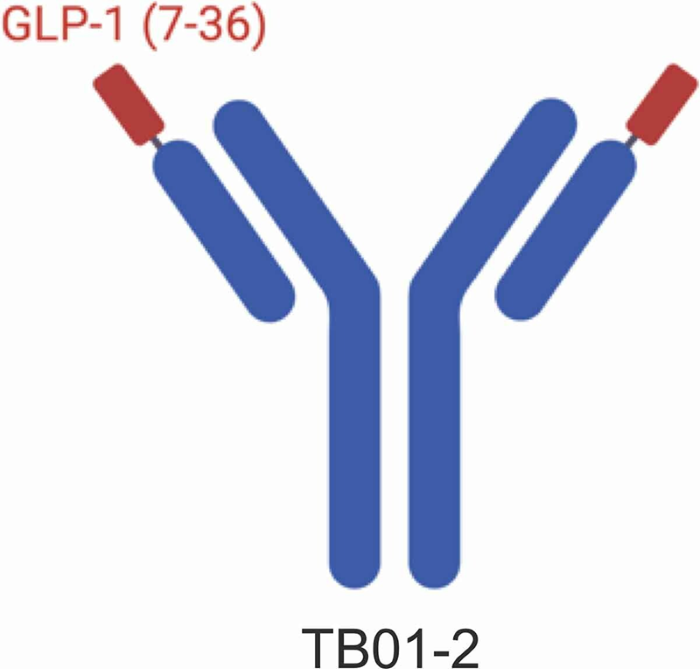In 2023, the global market for anti-obesity drugs reached US $ 6 billion. Goldman Sachs forecasts a more than 16-fold increase by 2030, reaching a total of $100 billion.

Image Credit: ACROBiosystems
Recently, the glucago*-like peptide-1 receptor (GLP-1R) has become a primary target in diabetes and obesity treatment because of its role in controlling blood sugar and weight.
Peptide-based GLP-1R agonists have displayed substantial efficiency in lowering blood sugar and promoting weight loss. Improvements in antibody drug technology have resulted in the development of GLP-1R antibody treatments, which offer the potential for more effective, safer, and longer-lasting treatments.
GLP-1R’s structure
GLP-1R, a key member of the class B G protein-coupled receptor (GPCR) family, features a distinctive seven-transmembrane domain (TMD) and an extracellular domain (ECD) of 120 to 160 amino acids.
Both the ECD and TMD are vital for GLP-1R's interaction with its peptide ligand GLP-1 and following activation. The ECD binds the ligand and anchors it to the transmembrane region, inducing conformational changes in the TMD and recruiting downstream G proteins.
If no ligand is present, weak interactions between the ECD and TMD prevent receptor activation by blocking ligand binding, acting as a negative regulatory mechanism.

Activation process of full-length GLP-1R. Image Source: https://doi.org/10.1038/s41467-020-14934-5
GLP-1R’s biological functions
GLP-1R is extensively distributed throughout the body, including in the pancreatic beta cells, the stomach, the intestines, the brain, and the heart. It interacts with GLP-1 to control insulin secretion and blood sugar levels.
GLP-1R plays a role in appetite regulation and weight management while also providing neuroprotective and cardiovascular benefits, making it a key target for treating diabetes, obesity, and related conditions.

Biological actions of GLP-1 on target tissues. Image Source: https://doi.org/10.3389/fendo.2022.838410
The landscape of GLP-1R-targeted drug development
Mainstream: Peptide-based GLP-1R therapeutics
Thanks to its dual role in regulating blood sugar levels and promoting weight loss, GLP-1R has become a primary target in diabetes treatments and aesthetic medicine.
GLP-1R's high affinity for peptide ligands makes peptide-based therapeutics the main form of GLP-1R-targeted therapies. However, the native GLP-1 molecule is rapidly degraded by dipeptidyl peptidase-4 (DPP-4) and glomerular filtration and requires modifications to extend its half-life.
To tackle this, several peptide-based GLP-1R agonists have been developed and approved, improving their half-life, efficacy, and bioavailability. These agonists effectively mimic the glucose-lowering and weight-loss effects of endogenous GLP-1.

Methods to enhance GLP- 1R action. Image Source: https://doi.org/10.3389/fendo.2022.838410
GLP-1R antibody therapeutics
As macromolecular drugs, antibody therapies provide greater specificity and affinity than peptide-based drugs. This allows for precise targeting of antigens like GLP-1R while minimizing the risk of nonspecific binding and side effects.
Antibodies also have the advantage of extended circulation through the neonatal Fc receptor (FcRn), which prolongs their half-life and reduces the frequency of dosing. Additionally, their immunomodulatory properties enhance effectiveness through interactions with Fc receptors (FcR).
While peptide-based therapies often require weekly or more frequent administration, GLP-1R agonist antibodies offer a promising alternative. Several are currently being developed to address the limitations of frequent administration.
Glutazumab
Glutazumab (Gmax Biopharm) is a novel antibody-drug that targets GLP-1R directly. It was created for the treatment of obesity and type 2 diabetes and features a fusion of a 23-amino-acid peptide linker and a DPP-4-resistant GLP-1 (7-35) fragment attached to the light chain of a humanized GLP-1R antibody.
The most advanced clinical trial of Glutazumab is currently in phase III. Clinical data show it surpasses similar GLP-1 analogs in safety, tolerability, and glucose-lowering and weight-loss effects. This positions Glutazumab as a potential next-generation, ultra-long-acting treatment for diabetes and obesity.

Schematic diagram of Glutazumab. Image Source: https://doi.org/10.1016/j.bcp.2018.01.029

The pipeline of Gmax Biopharm. Source: Gmax Biopharm official website
Regeneron's ATDC technology
In September 2023, Regeneron patented antibody-tethered drug conjugates (ATDCs) (WO2023173132A1). The technology combines an antibody targeting the extracellular domain of GLP-1R with a GLP-1 mimetic to form ATDCs.
The GLP-1R antibody identifies GLP-1R on the cell's surface and inserts the modified GLP-1 peptide into the receptor, which enhances ligand binding. Compared to traditional peptide therapies, ATDCs enhance affinity and increase molecular weight, improving stability and a longer half-life for GLP-1 peptide analogs.

The mechanism of ATDC. Source: Patent No. WO2023173132A1
Everestmab
Everestmab is an anti-GLP-1R antibody with agonistic effects achieved through fusion with a GLP-1 peptide segment.
It has three domains: a mutated GLP-1 (A8G) fragment with enhanced DPP-4 resistance, a humanized human serum albumin (HSA) nanobody that binds HSA to extend half-life by preventing rapid clearance, and a humanized GLP-1R nanobody that activates the GLP-1R signaling pathway upon dissociation from HSA.

Structure and the prolonged persistence mechanism of everestmab in vivo. Image Source: https://doi.org/10.1080/21691401.2020.1770268
TB59-2 antibody
Researchers used a GPCR synthetic antibody phage display library to identify the anti-GLP-1R antibody TB01-2, which exhibits strong binding but lacks agonistic activity. By fusing the active GLP-1 (7-36) fragment to the N-terminus of TB01-2’s light chain, they developed TB59-2.
This fusion significantly improves the antibody's activity and stability, replicating the function of endogenous GLP-1. As a result, it effectively activates GLP-1R, promoting insulin secretion and reducing blood glucose levels.

Design of TB59-2. Image Source: https://doi.org/10.1080/19420862.2021.1893425
Novel full-length GLP-1R protein
While peptide-based drugs dominate GLP-1R-targeted therapies, antibody-based GLP-1R drugs hold significant clinical promise.
To address the challenges of expressing and obtaining the natural conformation of the seven-transmembrane GLP-1R, ACROBiosystems has developed a full-length GLP-1R protein using the "FLAG" system.
Expressed in HEK293 cells and validated through its binding with GLP-1R agonists, this protein supports the development of GLP-1R-targeting antibody drugs.
References and further reading
- Li, C., et al. (2018). Glutazumab, a novel long-lasting GLP-1/anti-GLP-1R antibody fusion protein, exerts anti-diabetic effects through targeting dual receptor binding sites [J]. Biochemical Pharmacology, 150, pp.46-53. https://doi.org/10.1016/j.bcp.2018.01.029
- Liu, Q., et al. (2021). Functional GLP-1R antibodies identified from a synthetic GPCR-focused library demonstrate potent blood glucose control[C]//MAbs. Taylor & Francis, 13(1):1893425. https://doi.org/10.1080/19420862.2021.1893425
- Pan, H., et al. (2020). Everestmab, a novel long-acting GLP-1/anti GLP-1R nanobody fusion protein, exerts potent anti-diabetic effects [J]. Artificial cells, nanomedicine, and Biotechnology, 48(1), pp.854-866. https://doi.org/10.1080/21691401.2020.1770268
- Tan, Q., et al. (2022). Recent advances in incretin-based pharmacotherapies for the treatment of obesity and diabetes [J]. Frontiers in Endocrinology, 13, pp.838410. https://doi.org/10.3389/fendo.2022.838410
- Wu, F., et al. (2020). Full-length human GLP-1 receptor structure without orthosteric ligands [J]. Nature communications, 11(1), pp.1272. https://doi.org/10.1038/s41467-020-14934-5
About ACROBiosystems
ACROBiosystems is a cornerstone enterprise of the pharmaceutical and biotechnology industries. Their mission is to help overcome challenges with innovative tools and solutions from discovery to the clinic. They supply life science tools designed to be used in discovery research and scalable to the clinical phase and beyond. By consistently adapting to new regulatory challenges and guidelines, ACROBiosystems delivers solutions, whether it comes through recombinant proteins, antibodies, assay kits, GMP-grade reagents, or custom services. ACROBiosystems empower scientists and engineers dedicated towards innovation to simplify and accelerate the development of new, better, and more affordable medicine.
Sponsored Content Policy: News-Medical.net publishes articles and related content that may be derived from sources where we have existing commercial relationships, provided such content adds value to the core editorial ethos of News-Medical.Net which is to educate and inform site visitors interested in medical research, science, medical devices and treatments.